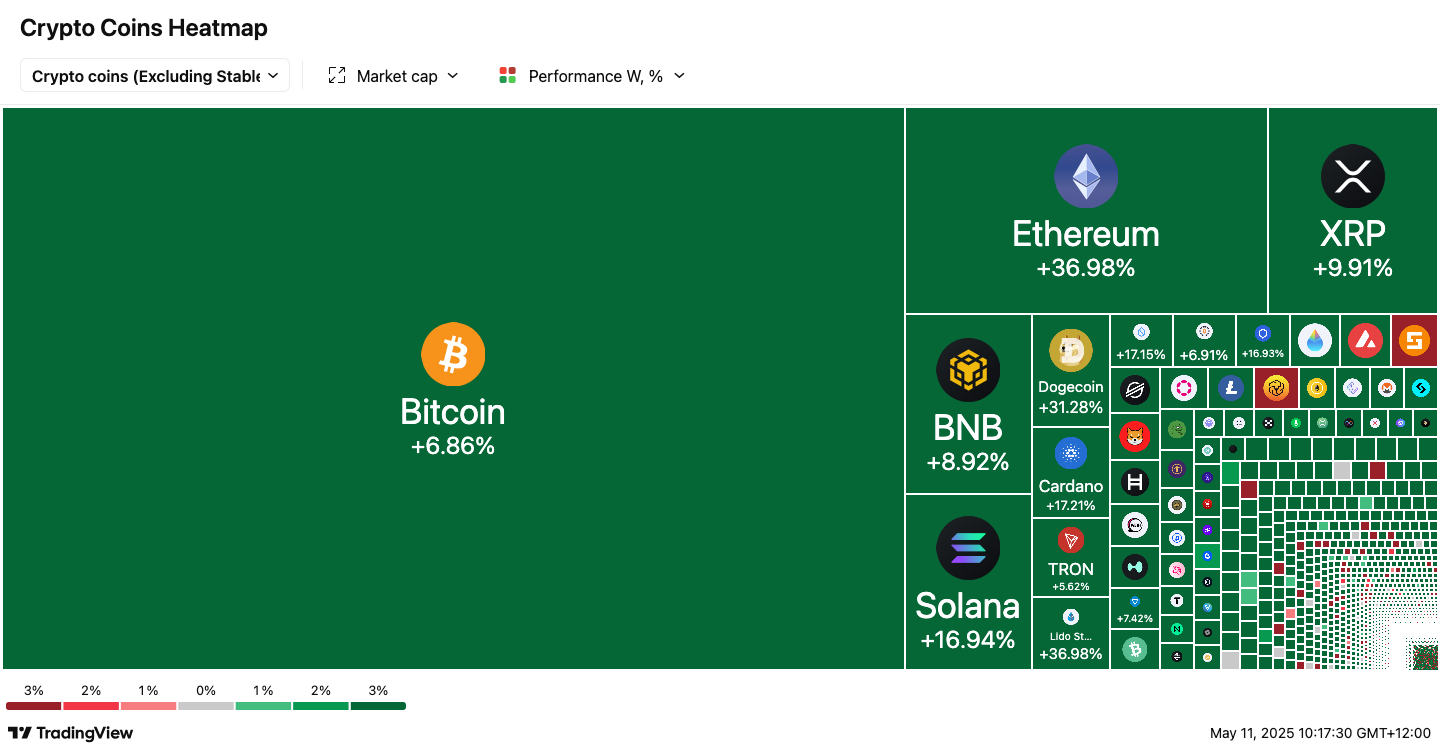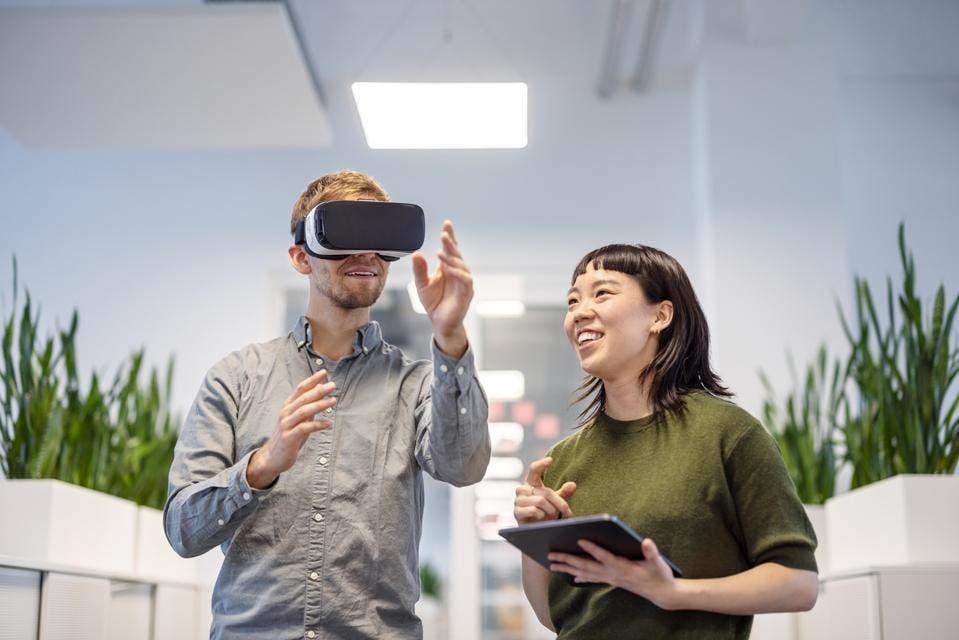📔 Weekly Journal: The Ethics of AI Avatars of the Deceased
[6 min read] Your weekend guide to getting ahead on the digital frontier. I’ll explore the implications of a recent AI generated video of a deceased victim played in court, “speaking” to the accused.
Welcome to this week’s Weekly Journal 📔, your guide to the latest news & innovation in emerging technology, digital assets, and our exciting path to the Metaverse. This is week 127 of the 520 weeks of newsletters I have committed to, a decade of documenting our physical and digital lives converge. New subscribers are encouraged to check out the history & purpose of this newsletter as well as the archive.
- Ryan
🌐 Digital Assets Market Update
To me, the Metaverse is the convergence of physical & virtual lives. As we work, play and socialise in virtual worlds, we need virtual currencies & assets. These have now reached mainstream finance as a defined asset class:
🔥🗺️Heat map shows the 7 day change in price (red down, green up) and block size is market cap. Lots of green!
🎭 Crypto Fear and Greed Index is an insight into the underlying psychological forces that drives the market’s volatility. Sentiment reveals itself across various channels—from social media activity to Google search trends—and when analysed alongside market data, these signals provide meaningful insight into the prevailing investment climate. The Fear & Greed Index aggregates these inputs, assigning weighted value to each, and distils them into a single, unified score.
🗞️ Metaverse news from this week:
A courtroom in Arizona may have quietly previewed the future of the metaverse: one where the dead speak—not symbolically, but literally.
On May 1, during the sentencing of Gabriel Paul Horcasitas for a 2021 road-rage killing, an AI-generated avatar of U.S. Army veteran Christopher Pelkey appeared in Maricopa County Superior Court to deliver a personalised message. Created by his family using generative AI tools, the avatar addressed Horcasitas directly, expressing a calm and almost compassionate tone: “In another life, we probably could have been friends.” Though not evidence, the video was permitted as a victim impact statement, and its emotional weight was unmistakable. But beyond the courtroom, this moment foreshadows a powerful and controversial aspect of the emerging metaverse: digital resurrection.
As spatial computing and generative AI evolve, the line between memory and simulation blurs. What began as a tribute to the deceased could become an enduring presence—avatars that "live on" in persistent virtual spaces, interacting with family members, appearing at life events, or even continuing conversations indefinitely. Experts are divided. Some see therapeutic or educational value in preserving the personalities and voices of loved ones. Others warn of ethical and psychological risks. “Simulations have gotten so good that they bypass our natural skepticism and go straight to our emotions,” said Harry Surden, a law professor at the University of Colorado.
In a metaverse future, will avatars of the deceased become a new form of memorial? Will they be visited, consulted, or even allowed to evolve through AI learning? For the Pelkey family, the purpose was humanisation and remembrance. But the precedent they’ve set raises deeper questions about agency, legacy, and how long a digital self should endure. As the metaverse becomes not just a space for the living but a canvas for memory, this case signals a profound shift: our digital selves may not end when our physical ones do.
Report: Spatial Computing Market to Hit $600 Billion by 2032 Amid Metaverse and AI Boom.
The global spatial computing market is set to grow from $129 billion in 2023 to $600 billion by 2032, according to DataIntelo, driven by rising demand for immersive experiences, enterprise digital transformation, and AI integration. Spatial computing—which merges digital and physical worlds through AR, VR, and geospatial tech—is gaining traction across industries like healthcare, manufacturing, and retail. Its role in powering the metaverse, digital twins, and real-time collaboration is especially significant.
Tech giants such as Apple, Meta, and Microsoft are heavily investing in next-gen wearables, while AI is enhancing spatial awareness and automation in everything from smart cities to robotics. Challenges remain, including hardware costs and privacy concerns, but rapid advances in 5G, AI, and cloud infrastructure are expected to fuel adoption. Spatial computing is increasingly seen as a core layer of the future digital economy.
👓 Read of the Week: Beyond VR: How Spatial Computing Can Transform Workplace Collaboration
As we advance into the Work From Metaverse (WFM) era, Hemant Madaan offers a timely exploration of how spatial computing is redefining collaboration far beyond what Zoom or Slack ever could.
Key insights from the article:
🌐 From Flat to Fully Dimensional
Traditional 2D tools fall short in expressing spatial nuance and complex workflows. Spatial computing—via AR, VR, and MR—introduces shared, immersive environments where teams can co-create, move objects, and review designs in ways that feel physically present, even across continents.
🛠️ The Real-Time, Sensory-Driven Workspace
Madaan shares his experience building a VR collaboration platform powered by multimodal AI—processing vision, spatial gestures, and text data—to enable synchronised, multi-user collaboration. Tools like Photon (Unity), Firebase, and 360° video streaming were key to making this seamless.
🧠 From Information Sharing to Experience Sharing
Collaboration is no longer just about documents and calls—it’s about shared experiences. Whether it's manipulating 3D task boards or walking through digital prototypes, spatial computing enhances focus, engagement, and team alignment.
🚀 The Business Case for Spatial-First Workflows
As Apple Vision Pro and similar devices hit the market, spatial computing is poised to become mainstream. It’s not just a UX upgrade—it’s a strategic shift that reimagines digital workspaces to be more human, embodied, and effective.
🔮 Why It Matters Now
The metaverse of work isn't some distant vision. It’s here. And as Madaan argues, business leaders who invest now in spatial capabilities will be the ones to shape the next normal of immersive, inclusive, high-performance collaboration.
🎥 Watch of the week:
Following on from the article above you can watch this AI-generated avatar of a man, who died in a road rage incident in 2021, addressed an Arizona court this month at the sentencing of the man who shot him.
AI Showcase🎨🤖🎵✍🏼: Pope Leo XIV Identifies Artificial Intelligence as Defining Moral Challenge of Our Time
In the Metaverse, AI will be critical for creating intelligent virtual environments and avatars that can understand and respond to users with human-like cognition and natural interactions.
In his first address to the College of Cardinals, newly elected Pope Leo XIV has declared artificial intelligence (AI) one of the most urgent ethical challenges facing humanity, calling for renewed focus on justice, labour, and human dignity in the age of intelligent machines.
Speaking in Italian at the Vatican on Saturday, the first American pontiff invoked the legacy of his predecessor, Pope Francis, who warned that AI could reduce human relationships to "mere algorithms" and had urged international regulation. Pope Leo vowed to carry that vision forward, pledging to uphold the “precious legacy” of Francis, who passed away last month. Echoing the social teachings of Pope Leo XIII—his namesake—who defended workers' rights during the industrial revolution, Pope Leo XIV drew a striking parallel between the upheavals of the late 19th century and the transformations now being triggered by AI.
“Just as my namesake spoke out in defence of workers at the dawn of mechanisation, today we must respond to the new revolution brought by artificial intelligence,” Leo said. “We must ensure that the algorithm does not become the new oppressor.” He cited AI’s implications for labour, justice, and peace, and signalled that the Church must play a guiding role in shaping a “human-centric future,” where technology serves ethical and spiritual goals, rather than eroding them.
Later in the day, the pontiff made a surprise pilgrimage to the Sanctuary of the Madonna of Good Counsel in Genazzano, south of Rome, a site significant to his Augustinian order. There, he greeted onlookers and offered blessings, marking a pastoral gesture early in his papacy. As AI reshapes global society—from surveillance and warfare to employment and intimacy—Pope Leo’s early prioritisation of the issue positions the Church as a moral voice in debates that will define the 21st century.
That’s all for this week! If you have any organisations in mind that could benefit from keynotes about emerging technology, be sure to reach out. Public speaking is one of many services I offer.





